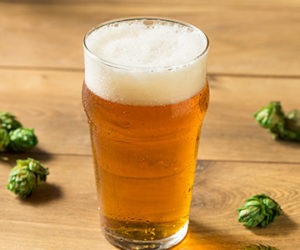Understanding Diacetyl
Beer is an alcoholic beverage, a fact we appreciate every time we taste a non-alcoholic beer. The alcohol in beer is produced during fermentation. Fermentation also produces a small amount of highly volatile compounds that are largely responsible for beer flavor. Some are of great importance and contribute directly to beer flavor, while others form part of the vast number of compounds responsible for beer’s background flavor.
Diacetyl: butter in your beer
Few flavor compounds evoke such strong feelings among brewers as diacetyl. Opinions of diacetyl range in intensity from ambivalence to utter hatred. At low levels, diacetyl is characterized by a sweet, butterscotch aroma and flavor. As diacetyl levels rise, so does the intensity of the butter character. Eventually the beer will smell like the foyer of a movie theater, as the character resembles rancid butter. Diacetyl can also give beer a mouth-coating characteristic that will make it difficult to drink.
What is it?
Diacetyl is one of a small class of compounds known as vicinal diketones (VDKs). (“Vicinal” means adjacent, “di” means two and a ketone is an organic compound with a double-bonded oxygen somewhere inside the molecule.) Diacetyl is the common name for 2,3 butanedione. The other common VDK in beer is 2,3 pentanedione. The flavor threshold of 2,3 pentanedione is 10 times that of diacetyl, meaning that there needs to be 10 times more 2,3 pentanedione present for the taster to detect it. This means that 2,3 pentanedione is rarely considered alone as a beer flavor problem. The flavor threshold of diacetyl is 0.04 ppm in U.S. lagers, 0.08 ppm in lighter ales, and 0.1 ppm in stronger beers.
Levels of diacetyl rise during early fermentation, then fall as the beer matures. Understanding the control of diacetyl character in beer is easier if the brewer has an understanding of the biochemical mechanisms by which it is first created, then removed.
Formation
While yeast cells synthesize certain key amino acids — such as valine, leucine and isoleucine — various intermediates are created in excess. In the case of diacetyl, the precursor is alpha acetolactate, which is excreted from the cell as the requirement for valine and leucine diminishes. Once outside the cell, alpha acetolactate can be oxidized to diacetyl. There are many oxidizing agents in wort that can do this, and this is a spontaneous (not enzyme-catalyzed) reaction. Alpha acetolactate is flavorless and aromaless, but diacetyl is strongly flavored and has a low flavor threshold. That’s the bad news. The good news is that healthy, happy yeast will later be able to reabsorb diacetyl. The yeast will then reduce it, first to acetoin, then to 2,3 butanediol. Acetoin has a musty flavor and 2,3 butanediol has a high flavor threshold. So, diacetyl flavor will appear in your beer during fermentation, and then your yeast will remove it for you during conditioning.
Diacetyl formation
Many factors lead to an increase in diacetyl production.
Yeast strain. Different yeast strains differ in their ability to produce (and remove) diacetyl.
Rate of fermentation. A fast, healthy fermentation reduces the release of alpha acetolactate into the wort. Ideally, wort gravity should drop to its terminal level in three to five days for ales. In lagers, five to seven days is usually required.
Temperature. Higher temperatures lead to more diacetyl formation. For example, a lager beer that is fermented at 57° F can produce up to three times as much diacetyl as a similar beer fermented at 40° F.
Yeast growth. Factors that inhibit yeast growth also result in the release of the alpha acetolactate into the wort. These factors include yeast nutrient deficiencies, a too-low temperature for fermentation, lack of wort aeration or low yeast vitality.
Pitch rate. A higher pitching rate will lead to an increase in the formation of alpha acetolactate. However, pitching a sufficient amount of yeast is necessary for a healthy fermentation.
Wort quality. The wort must contain sufficient amino acids or the yeast will need to manufacture them. Amino acid production will result in more formation of alpha acetolactate.
Diacetyl removal
The presence of sufficient healthy yeast during aging increases diacetyl removal. Yeast remove diacetyl much faster than they produce it. Sending the beer into secondary fermentation or maturation with some yeast still in suspension should be sufficient to reduce the diacetyl in a timely manner. The majority of the yeast will sediment. The yeast that remains in solution will hopefully be sufficient for maturation.
Diacetyl removal is accelerated at higher temperatures. Some lager brewers raise the temperature of the beer to around 57–61° F for a day or so after primary fermentation and prior to cold conditioning. This is called a diacetyl rest. Ale brewers can also perform a diacetyl rest by waiting for a couple of days after primary fermentation is over before chilling the beer.
At pH levels between 4.2 and 4.4, the conversion of alpha acetolactate to diacetyl is rapid. This rate decreases as the pH rises.
The addition of actively growing yeast along with the fresh wort encourages a rapid removal of diacetyl in the finished beer.
Increasing the surface area for yeast sedimentation also speeds diacetyl removal. This will allow the use of a flocculant strain and still shorten the maturation time. It can be achieved by using beechwood chips or horizontal maturation tanks. Laying your Cornelius tank on its side helps.
Residual diacetyl
The amount of diacetyl left in finished beer is a result of the interaction between the mechanisms of diacetyl formation and diacetyl removal. The timing of some events, such as beer transfers, can also be important.
Poor wort aeration leads to diacetyl. Yeast use oxygen absorbed at the start of fermentation to desaturate fatty acids which, in turn, increases the fluidity of membranes produced in subsequent generations. Cells with less fluid (or rigid) membranes late in the fermentation, or in maturation, are less able to reabsorb diacetyl.
Diacetyl levels may be too high if the beer experienced too short of a maturation period. It takes time for yeast to remove diacetyl. The large lager brewers of the world use the final disappearance of diacetyl below its flavor threshold as their criteria for determining how long the maturation period should last, usually three to four weeks. Care must be taken to ensure a complete conversion of the precursor to diacetyl, since alpha acetolactate can oxidize to diacetyl at any time. If this reaction happens after the yeast has been removed, there is no other mechanism available by which diacetyl can be removed.
If your yeast is very flocculant, then it may drop out of the beer before it has the chance to reabsorb the diacetyl. Some English, Canadian and U.S. ale brewers use flocculant yeast strains that require a recirculation pump to keep them in contact with the wort until diacetyl can be absorbed. A system that also allows oxygen contact, or even just an open fermenter, can cause an increase in diacetyl in beer. A Yorkshire square fermenter is a two-chambered vessel designed for use with a non-flocculant yeast. Wort is collected into the larger, lower chamber and the yeast rises through a manhole into the upper chamber. A pump continually recirculates the wort from the bottom chamber and sprays it over the yeast in the top chamber, re-suspending it and allowing it to mix back in with the bulk of the wort. This results in a lot of wort aeration, yeast growth and hence diacetyl production. The fact that the yeast is very flocculant means that it doesn’t reduce diacetyl once it’s formed in the beer.
Mutated yeast can also lead to diacetyl in your finished beer. One of the most common yeast mutations is one that causes the yeast to lose the ability to reduce diacetyl. On an agar plate, these cells produce small colonies, which explains why they are called “petite mutants.”
Crash-chilling too early will leave diacetyl in beer. Some brewers ferment in the primary fermenter until the terminal gravity is reached, and then crash-chill the fermenter to around freezing point to “drop out” the yeast. Unfortunately, if the yeast is dormant and stuck on the bottom of the fermenter, it isn’t up in the beer where it can be removing the diacetyl.
Uptake of oxygen late in fermentation leads to excessive diacetyl production. Yeast will begin releasing more alpha acetolactate if oxygen is introduced late in the fermentation. This eventually leads to an increase in diacetyl, so care must be taken to avoid oxygen pickup during beer transfers.
Diacetyl can come from bacterial contamination. Lactic acid bacteria are capable of producing diacetyl by a similar pathway to that used by yeast. However, they are unable to reduce it again. This was once known as “sarcina sickness” after the original name for Gram-positive brewery bacteria.
Clean brewing equipment and a yeast carrying a low contamination load will ensure that bacterial sources of diacetyl will be minimal. If your procedures are geared toward minimizing diacetyl and it suddenly shows up, this is the first place to look.
And in conclusion…
So what can homebrewers do to control the level of diacetyl in their beer? First, conditions need to be appropriate to minimize the release of the alpha acetolactate into the wort. There must then be a rapid conversion of this precursor to diacetyl. This should be followed by effective removal of any diacetyl that is formed.
Diacetyl removal is helped by a strong, rapid fermentation performed by well-aerated, correctly pitched yeast. A large, early reduction in wort pH, and the prevention of further oxygen uptake later in the fermentation will also help. A short period of warm conditioning will help to convert all of the precursor still in the wort into diacetyl. Then it is essential that enough live, active yeast are present during maturation to remove the remaining diacetyl.



